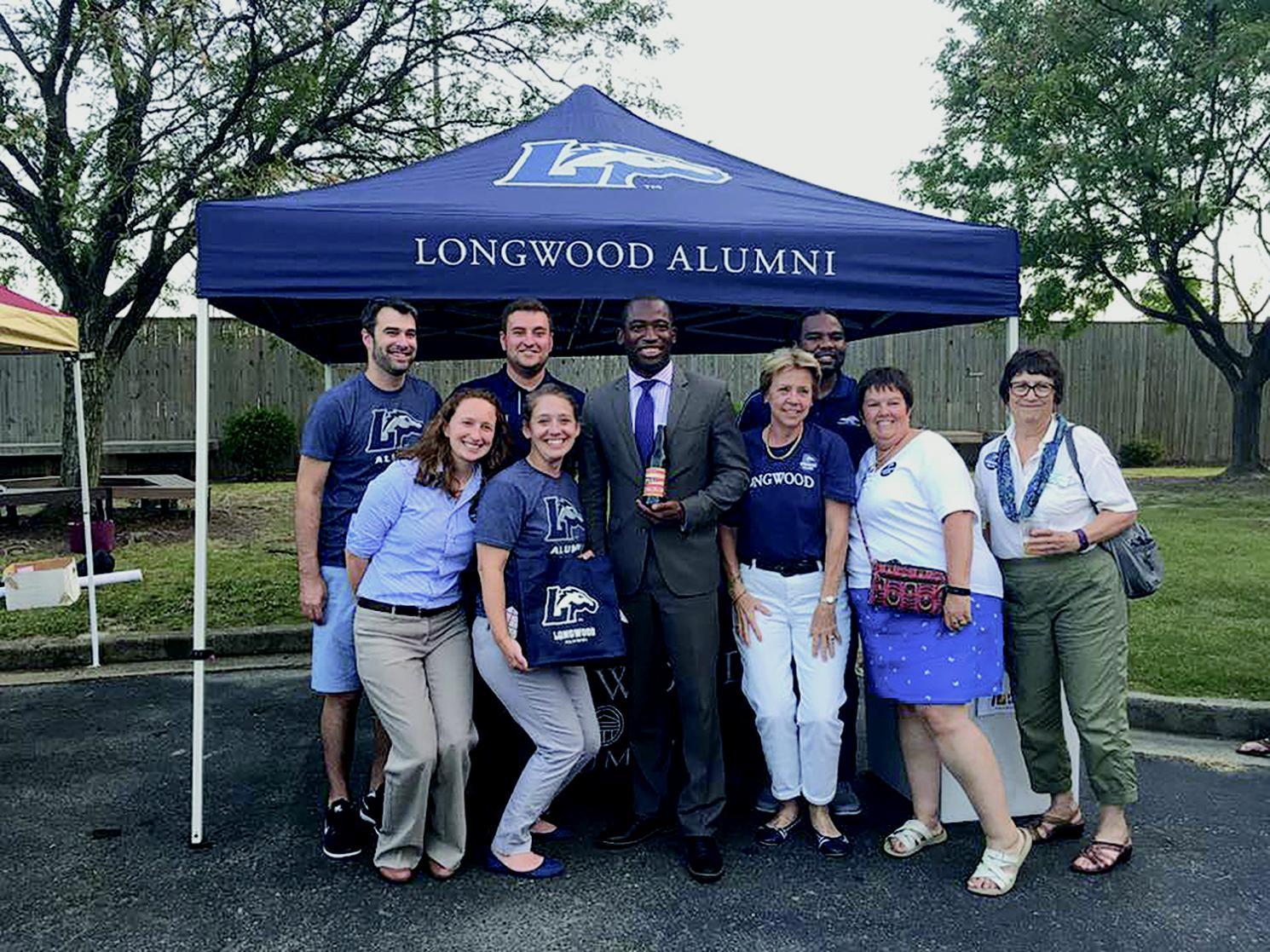
Fall 2017
From the President

When it comes to higher education, there is one topic that is never far from my own mind or that of the public: how much college costs. I am proud that Longwood has taken the lead in Virginia over the last four years with, by a wide margin, the smallest tuition increases of any four-year public university.
Still, many of our students and their families cannot afford Longwood on their own, and rely on a combination of state and federal student aid as well as scholarship dollars provided by the Longwood University Foundation. More than half of our students receive either grants from the government or Foundation scholarships that lower what they have to pay or borrow. Scholarships aren’t just essential for getting students in the door of college. They’re also extraordinarily effective at keeping students on track to graduation: The retention rate for students who receive scholarships from the Longwood University Foundation is well above 90 percent.
The good news is we’ve been making sure Longwood remains accessible to a broad range of students. The proportion of first-generation college students in our entering freshman class has grown from 14 percent to 19 percent in just two years. Over four years, the number of Longwood students receiving Pell Grants—the federal award for students from the very lowest-income families—has increased 13 percent, and the number of students from underrepresented groups has increased by more than a quarter. That said, there is still tremendous ground to cover—and given the long-term prospects for state support, we will likely have to cover much of that ground ourselves. Longwood’s scholarship endowment of roughly $36 million provides about $1.6 million in scholarships annually, which on a per-student basis does not go far compared with many of our peer institutions.
These scholarship funds overseen by the Longwood University Foundation are often donated in honor of friends and relatives, or favorite teachers, or to support students in particular fields. There is almost nothing in our work more satisfying than the connection Longwood helps make between scholarship donors and the roughly 430 undergraduate students who receive their help each year. That connection is on vivid display each February, when many donors and recipients meet in person at our annual scholarship dinner. Still, every year talented young people who would love to come to Longwood—and would thrive here—choose another institution because we cannot offer sufficient financial aid.
That is why, even amidst other important priorities, I continue to make fundraising for scholarships a top focus. In recent months, the Longwood University Foundation has begun to freshly direct its energies toward boosting our scholarships and improving how we deploy scholarship dollars to help students. The goal is to do the most possible good with every dollar our supporters have generously contributed, ensuring those funds get to the neediest and most deserving students. The Foundation staff and board, representing some of Longwood’s most loyal and committed supporters, have taken up that challenge, working hard on new strategies and practices to make sure we’re doing everything we can to keep costs and student debt down.
Thank you for your support of Longwood, which truly does transform lives down through the generations.

W. Taylor Reveley IV
President
-
The Science and Art of Reading
November 20, 2017
As a center of pedagogical excellence— and host to a burgeoning children’s book festival— Longwood is leading the fight to keep kids reading
-

Fostering Better Foster Care
November 20, 2017
Longwood community works on many fronts to make the system better for one of society’s most vulnerable populations.
-

Speaking for the Trees
November 20, 2017
Meet the unwavering champion of Longwood’s ginkgo, windmill palms, magnolias, catalpas, maples, firs, fig, locusts, crape myrtles, cypresses, pecans, pines, cedars, oaks...
-

422-Year-Old Southern Red Oak is Longwood’s Oldest Tree
November 20, 2017
Mary Farley Ames Lee ’38, who later bequeathed her 626-acre farm on the Potomac River to Longwood, asked me to find out.
-
MAKING AN ENTRANCE
November 20, 2017
New Tenure-Track Faculty Infuse Campus with Fresh Experiences, Enthusiasm, Ideas
-

On the Up and Up
November 20, 2017
Boom in early applications comes on the heels of increased name recognition, successful summer admissions program
-
Issues and Answers
November 20, 2017
First Brock Experience courses exploring civic issues being developed
-
Dos Passos Prize honors work that explores Asian American life
November 20, 2017
Chang-rae Lee, author of five novels and a professor of English at Stanford, is the 2017 winner of Longwood’s Dos Passos Prize for Literature.
-

Aiming High
November 20, 2017
Star chemistry major, student-athlete is first nominee in modern era for Rhodes Scholarship
-
Longwood climbs in latest rankings
November 20, 2017
Longwood is rising in national prominence, with increased application numbers and graduation rates
-
LCVA Winter Gala set for March 3 in new campus venue
November 20, 2017
Partygoers will have more room to dance, to chat and to consider works up for auction
-
-

Going, Going, Gone
November 20, 2017
Longwood aids state agency in assessing erosion threat to coastal archaeological sites
-
-
-

Guide Post
November 20, 2017
Leading tours and working with prospective students gives scholarship recipient a new venue for helping others
-

Herd Mentality
November 20, 2017
You’ve got about an acre and a half of land that’s overgrown with vines, brush and other vegetation.
-
-
A case of mistaken identity
November 20, 2017
In the July 2017 issue of Longwood magazine, the incorrect photo was used for one of the graduates featured in the story about the Class of 2017.
-
-
Sentimental Value
November 20, 2017
Find a home for your Longwood treasure in Greenwood Library Archives
-

Coming Soon: Bigger and Better Mega Reunion
November 20, 2017
Circle May 11-13, 2018, on your calendar for the second annual Mega Reunion.
-
Family Game Day set for Jan. 6
November 20, 2017
The third annual Alumni Family Game Day promises to offer fun and excitement for Lancers of all ages.
-

Alum creates campus mural that’s a happy walk in the park
November 20, 2017
Monty Montgomery ’98, an artist known for his murals, painted his latest on-campus mural in August
-

Alumni on the Road
November 20, 2017
Staff from the Offices of Alumni and Career Services hit the road this summer and early fall
-
Career Fairs are open to alumni
November 20, 2017
Alumni who are seeking jobs or recruiting employees are invited to attend three upcoming career fairs.
-

Longwood Network provides opportunities to reconnect
November 20, 2017
The Longwood Network—an online community just for Lancers—allows you to reconnect with former classmates
-

Launching a New Tradition
November 20, 2017
Family-style dining in Blackwell. Greeting friends in the Farmville train station. Singing in the Rotunda before dinner.
-

Firing on All Cylinders
November 20, 2017
Working as the operations manager for one of the world’s leading law firms is only the beginning for this nonstop alum
-

Creature Comforts
November 20, 2017
Veterinary practice incorporates nonconventional approaches to pet care
-
-
ClassNotes
November 20, 2017
Joan Brock ’64, and her husband, Macon Brock, were featured in the June issue of Virginia Business magazine for their longtime philanthropic efforts
-

A Summer to Remember
November 20, 2017
Athletics, academic programs join forces to make anthropology student’s dream come true
-

Lucky Charm
November 20, 2017
Renaming of field hockey turf ushers in season of unprecedented success
-
Armful of awards caps standout season for women’s soccer
November 20, 2017
Longwood women’s soccer will need to clear some room on the trophy shelf.
-
Q&A with Paige Robertson, women’s soccer
November 20, 2017
When I visited campus as a recruit, I noticed everybody was really nice and friendly, but I thought maybe it was just for show.
-

Body and Mind
November 20, 2017
Athletics creates new unit to holistically address the challenges student-athletes face
-

Good Things Come in Threes
November 20, 2017
Lancers reunite to coach undefeated Albemarle girls soccer team
-

Beating the Odds
November 20, 2017
Student won’t allow her experience as a foster child to define her life




